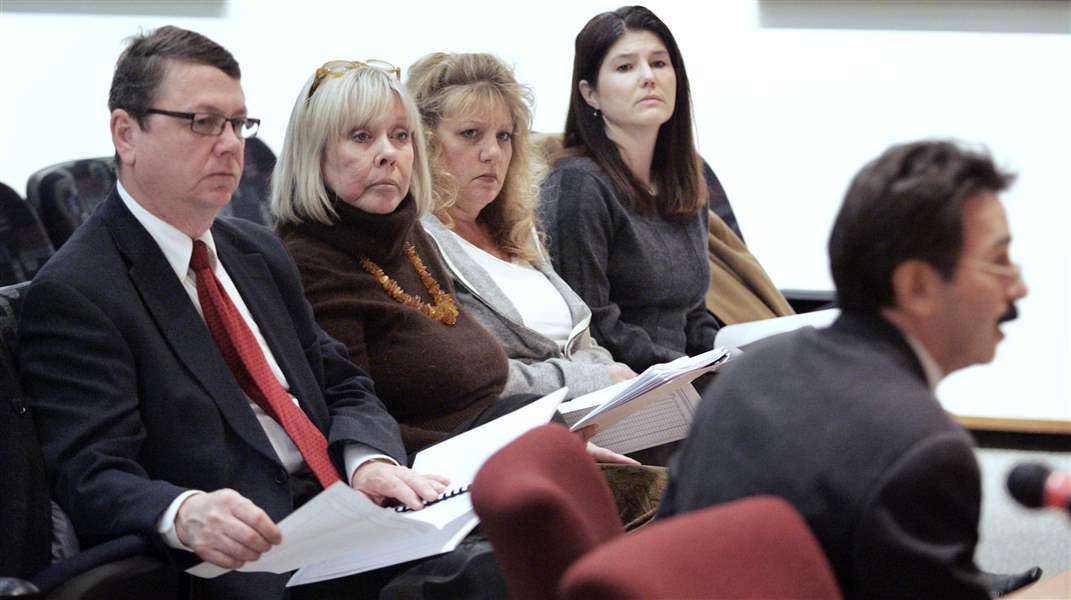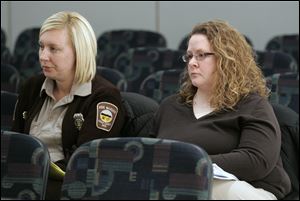
15 changes presented for Lucas County Dog Warden's Office
1/12/2011
Rob Ludeman, left, Carol Dunn, Debbie Johnson, And Tara Kestner, members of the advisory committee listen as chairman Steve Serchuk explains the 15 recommendations. The group plans to meet next month and then once a year.
The Blade/Dave Zapotosky
Buy This Image
A citizen-led oversight panel for the Lucas County Dog Warden's Office says there are 15 ways that the county significantly could improve public safety on the streets and animal welfare at the pound.
“It will be up to the county commissioners, the auditor, and the Lucas County dog warden and her staff to translate that vision into reality,” Steve Serchuk, chairman of the Lucas County Dog Warden Advisory Committee, said.
County commissioners formed the committee in late 2008 after an outpouring of complaints about then-Dog Warden Tom Skeldon, who detractors said euthanized too many dogs and adopted out too few.
The committee was highly critical of Mr. Skeldon in its first formal presentation in fall, 2009. Two months later, Mr. Skeldon resigned from office amid mounting public criticism. The former warden is now a rodent catcher for the Toledo-Lucas County Health Department.
Pete Gerken, president of the board of county commissioners, thanked the dog committee Tuesday for its nearly two years of work. He said the county will try to enact many of the final recommendations, though he cautioned that some may not be practical by the suggested deadline.
“Realistically, we can do a lot of these,” Mr. Gerken said after the meeting. “We can do the low-hanging-fruit stuff pretty quickly.”
Julie Lyle, the county's new dog warden, noted how the department has moved forward on some of the recommendations.

Rob Ludeman, left, Carol Dunn, Debbie Johnson, And Tara Kestner, members of the advisory committee listen as chairman Steve Serchuk explains the 15 recommendations. The group plans to meet next month and then once a year.
“A lot of these things are already in the works,” she said.
The 12-member committee includes representatives of the animal-welfare community as well as city councilmen, health officials, a police officer, a letter carrier, and others. The group plans to wind down its activities next month and meet just once a year.
Mr. Serchuk said he hopes that commissioners will take formal action within 30 days on some of the recommendations.
The 15 recommendations are:
• Starting a program of pound volunteers.
The committee called for recruiting at least 50 citizen volunteers by year's end who can assist the pound's paid staff by walking, grooming, and playing with the dogs, among other tasks. Ms. Lyle held orientation last month for the four people in the first volunteer class.
• Upgrading the dog pound.
A new or significantly renovated facility could improve the quality of life for impounded dogs and encourage more adoptions. The committee wants 50 percent of all dogs to be housed in kennels rather than in cramped cages by September, with every dog in a kennel by December, 2013.
An outside fenced exercise area should be built by June 1 to give dogs better exercise and socializing opportunities.
A feasibility study for a new dog pound should be completed by December, 2012. And if a new building isn't possible, the existing pound should be renovated.
• Collection, retrieval, and sharing of dog statistics.
The dog pound should work with the health department and Lucas County Auditor Anita Lopez to publish weekly dog warden department statistics on the Internet, beginning the first week in June. These statistics should include, among other data, the number of dogs seized, surrendered, adopted, transferred, and killed as well as the number of dog bites and the pound's “live release rate.”
• Reducing dog bites.
The dog warden should implement programs to cut the number of “serious” dog bites by 10 percent a year for the next five years. There are about 50 serious dog bites each year, as defined by bites that break the skin and require medical attention. The warden also should implement a program to reduce the number of bites that don't require medical attention among children under age 16, who are bitten most often.
• Better public safety education.
Start in-class bite prevention lessons at county elementary schools in areas with high numbers of dog bites and areas with the most dogs “running at large.” Also begin an education program in area hospitals' maternity wards about the dangers of leaving children unattended with dogs. In addition, start airing radio and TV public service announcements later this year.
• Improvement in returning dogs to owners.
The warden should try to return every dog wearing a license to its owner. Warden staff or Ms. Lopez's office should call or e-mail every owner before sending out the state-required certified letter. Deputies should increase the number of licensed dogs returned to their owners 10 percent each year in 2011, 2012, and 2013. There should be microchip scanners and computers in all deputy warden vans by June. By next January, all licensed dogs that are picked up should have photos posted on the dog warden's Web site.

Dog Warden Julie Lyle, right, with assistant Jessica Poupard, hears the panel's findings. Ms. Lyle said many of the changes for her department are in the works.
• Extending the pound's hours.
The committee asked that the pound extend its public hours so that more working people could visit. Ms. Lyle has done so: As of Jan. 3, the pound is open from 10 a.m. to 6 p.m. on weekdays and 10 a.m. to 5 p.m. on Saturdays. The previous hours were 9 a.m. to 4 p.m. on weekdays and 9 a.m. to noon on Saturdays.
• New hours for dog warden deputies.
Deputies are on patrol from 8 a.m. to 4 p.m., but call logs show that nearly 40 percent of all 911 calls about dogs occur between 4 p.m. and 9 p.m. The committee suggests a night shift, with more deputies patrolling from 4 p.m. to 9 p.m. or 10 p.m.
“This is the time that families are home and the time they are most likely to either encounter a stray dog or interact with family dogs,” the report said.
To accomplish this, the county should renegotiate its labor contract with the employees' bargaining unit to allow a new shift for deputies to work until 9 p.m. or 10 p.m.
Mr. Gerken said he doubts that the contract could be renegotiated by the committee's Jan. 31 benchmark date and noted that the deputies' union just agreed to its third salary freeze in as many years.
• Improving license compliance.
The dog warden needs more public service announcements on the benefits of buying a $25 dog license. There should be an e-mail database of licensed dog owners to allow for annual reminders for license renewal. The warden should obtain software that can track license compliance and target areas with low compliance for door-to-door visits, increase the number of license vendors, and implement an “I love my pet” license reward program similar to one in the Canadian city of Calgary, which provides a vendor discount and a rewards card for people who license their dog.
The committee also recommends increasing the fees and inspections of breeders and kennel-license holders to “discourage and eliminate backyard breeders.”
• Charging higher license fees for dogs that aren't spayed or neutered.
Dogs that aren't spayed or neutered are more likely to bite or attack. They also contribute to dog overpopulation.
The committee suggests higher licensing fees for these dogs starting in 2012 to encourage more spaying and neutering.
• Introducing better animal care and enrichment.
The dog warden should establish standard operating procedures to ensure the welfare and comfort of impounded dogs. These guidelines should be ready by June and include providing dogs with more comfortable housing and bedding and a walk and exercise schedule for them. The dogs also should socialize more with people and other dogs to reinforce good behavior.
• Improving veterinary services.
The pound should employ a veterinarian or group of veterinarians who are either familiar with standard shelter practices and medicine or willing to learn. Each impounded dog should receive a vet exam as soon as possible upon arrival.
The commissioners voted 3-0 last week to create such a vet position, which will replace the system of contracting out veterinary care
• Greater cooperation with outside rescue groups.
The dog warden should expand its network of partner rescue groups to 20 by year's end and to 30 by the end of 2012.
Rescue groups help the warden rehabilitate and place into homes dogs that might otherwise be euthanized. The current “live release rate” should be increase from about 50 percent to 55 percent by year's end, 65 percent by the end of 2012, and to 70 percent the following year.
• Changes to local and state dog-related legislation.
The county needs to work with the city of Toledo to enact and enforce all provisions in the city's new and progressive dog law. County commissioners should take a leadership role in encouraging all local governments in the county to adopt similar dog ordinances. Commissioners also should work with the Ohio County Commissioners Association and state representatives to modify and amend certain statutes to support the Toledo dog law.
• More funding sources.
The dog warden's budget comes almost entirely from license fees and fines, and the committee believes it should diversify its revenue sources.
The committee recommends that the dog warden apply for more public and private grants and partner with an organization so that it is eligible for more grants. The warden also should engage in fund-raising to subsidize its enrichment, adoption, and education efforts.
By year's end, 5 percent of the dog warden's budget should come from sources besides license, citation, and fee income.
Contact JC Reindl at:
jreindl@theblade.com,
or 419-724-6065.